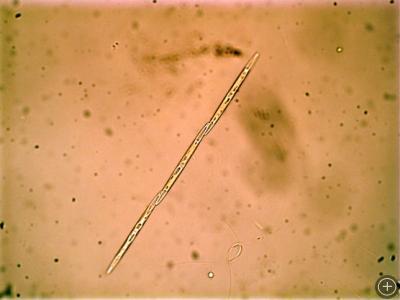Diatoms Can Be Toxic
March 15th, 2009
ABOARD THE RVIB N. B. PALMER, ON THE SOUTHERN OCEAN– Phytoplankton cells can become toxic under certain conditions. Still a mystery to scientists why they produce toxins, there has been a proliferation of large concentrations of toxic cells, or blooms, also called red tides, during the last 20 years. Dinoflagellates are the most common of the toxic algae. They can produce compounds that after concentration in the guts of animals that eat them can be damaging to humans consuming shellfish. Clams, mussels and oysters are well known vectors for these toxins. Large fisheries in the US coastal regions are closed during periods of toxic algal blooms.

The diatom Pseudonitzchia sp. in a chain with 3 cells. Determination of species requires analysis under a scanning electron microscope and will await return to the US. Small dots in the background are flagellates a few microns in size. Pseudonitzchia is a rather large pennate diatom, with two elongated valves, about 100 microns long. Some species form chains by attaching sideways to the next cell’s tip.
The diatom Pseudonitzchia, present in Antarctic waters, is well known for producing toxins. A large killing of birds in the Monterey area off the California coast made everyone aware of this alga. During this cruise we are collecting samples for Dr. Mary Silver at the University of California Santa Cruz who has studied this phenomenon in the world’s oceans. First thought to be only a coastal process, it seems Pseudonitzchia can be abundant in the open ocean, far from land. In this collaboration, Dr. Silver will measure the toxin domoic acid and we will provide the information on which species of Pseudonitzchia we collect and how many of the cells are found that can later be related to domoic acid concentration. In this way, Antarctic phytoplankton will be represented in the database of toxic phytoplankton species if indeed we find they produce toxins.










Hi Maria – given the high NPP in the high latitudes, it’s interesting that finding blooms in the open waters was not expected. Or do I have something backwards here? – Paul
Hi Paul,
The high NPP in high Antarcica is usually more restricted to coastal waters and/or the ice edge. It was surprising finding such a bloom in the fall when days get shorter and grazing is high. I have never seen anything higher than 3 milligrams of chlorophyll per cubic meter after February and here we saw a bloom in excess of 10 mg m-3, as healthy and abundant as during the spring and summer.
Glad you are reading the dispatches! I hope everything is well with you.
Sincerely, Maria
Respected Maddom (Maria Vernet)
I am Subrat Naik working as a research scholar under coastal ocean monitoring and prediction system (COMAPS) programme at Institute of minerals and material Technology (formerly RRL), Bhubaneswar, India. I basically from M.Sc, M.phil (Marine Biology).I am working on phytoplankton ecology. I saw ur work experiences and I very much attracted to ur work, if there is any oppertunity to do some plankton ecology work with you, then I will be very happy.
Thanking you